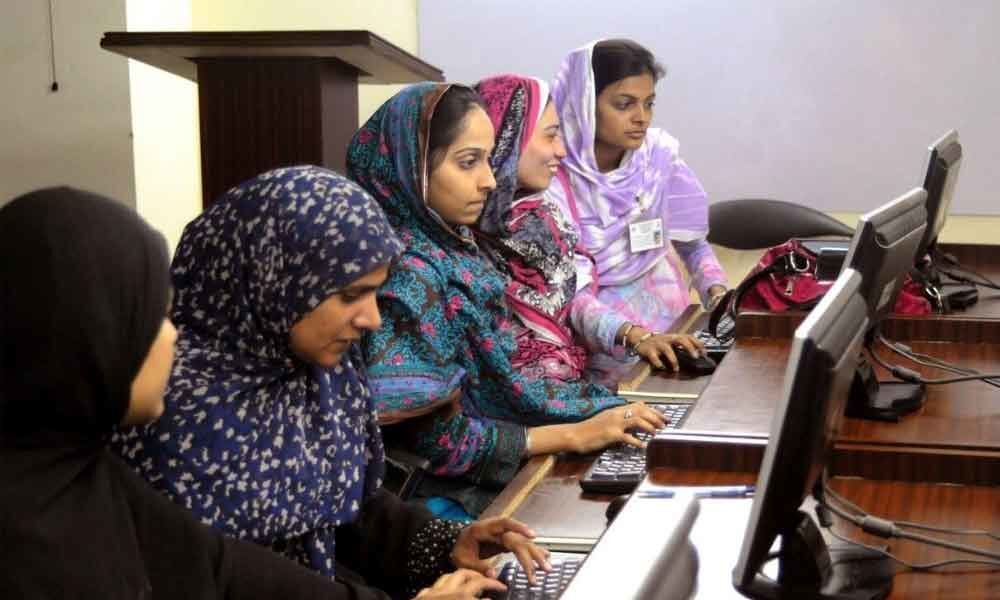Creating jobs in the digital economy

Use of computers and ATMs in banks have led to less numbers of clerks being required.
Use of computers and ATMs in banks have led to less numbers of clerks being required. Mobile phones have closed the business of STD Booths. Jeeps have led to the end of horse carriages. Power looms of Surat have killed the business of handlooms. Tractors have rendered the bullock cart obsolete.
The list of jobs lost goes on and on. Yet there is no catastrophe because new jobs have been created in computer software, mobile phone repair, maintenance of jeeps, transport of sarees from Surat, and diesel filling stations. Economist Joseph Schumpeter called this the process of "creative destruction."
The development of new technologies brings in new modes of production and new products leading to closure of many existing products and jobs in their manufacture. The pace of technological change appears to be increasing exponentially.
Self-driving cars and trains, artificial intelligence, cloud-based software, self check-in at airports are just a short list of the shakeup coming soon.
The history so far suggests that the number of new jobs created has been more than the numbers of old jobs lost. For example, the Employment Analysis website made by Financial Market Expert Michael Dulin says that "in 1900 there were 109,000 carriage and harness makers and virtually no electricians, but in 2002 there were virtually no carriage and harness makers and 882,000 electricians." The question is whether this happy trend will necessarily continue.
Economists have given different estimates of the numbers of present jobs that may be lost. One study by Carl Benedikt suggested that 47 percent of jobs in the United States may be lost due to computerisation.
The World Bank then published a blog by Melanie Artnz and others suggesting only 9 percent will be lost. The difference in numbers notwithstanding, the key question is whether the numbers of jobs created in new areas would be more?
I am hugely optimist. Let me try to explain by an example. Let us think of a farmer. Hitherto the farmer worked for six days in a week to produce the crops. Now, electricity, tractors and internet have made it possible for him to produce the same crops by working four days in a week. So, he has two days free for himself.
He decides to play music in these two days. He starts playing music in marriage ceremonies. This creates jobs for electricians. He also needs to buy music instruments from the market which create more jobs.
Thus, the loss of job of two days in farming leads to generation of more jobs of electricians and music instruments. The point is that the loss of job is ultimately due to the less time required in producing the goods.
It provides free time. Whatever people do in this free time — play music, run a shop, or travel — more jobs are created in these activities. It appears to me that there cannot be only job destruction without job creation.
The above example spoke of a single farmer. He who "lost" two days of job in agriculture and "gained" two days of job in music, leaving him fully employed. The situation changes when we talk about the economy in general.
The losers and the gainers can be different persons. A study undertaken for the International Labour Organisation of the United Nations says that one feature of the present technological change is that of "growing polarisation in the job market.
The returns to high-skilled labour are likely to increase, while those at the low-skilled end stagnate." Another study by the Metropolitan Policy Programme says: "Job growth has been rapid in high-digital level occupations, such as computer-mathematical and business-finance occupational groups, as well as in low-digital level occupations, such as personal care and food preparation.
By contrast, middle-digital occupations, such as office-administrative and education occupations have seen much slower job growth." The combined result of these studies is that numbers of jobs and the level of wages in high-skill category will increase, the middle-skill category will vanish, and numbers of jobs will increase in the low-skill category but with low wages.
We will have high-skilled engineers managing the aggregator platforms like Ola and low-skilled cab drivers. The jobs of middle-skilled taxi stand round the corner will vanish. Or, we will have high-skilled engineers managing online shops like Amazon and low-skilled delivery boys.
The jobs of middle-skilled shop keepers will vanish. I do not think the government can do much about saving the middle class. But the government can do much to create larger numbers of high- and low-skill jobs. That is the challenge before NDA 2. This requires that we take the lead in developing new technologies.
The strength of the United States lies in that country being at the forefront of new technological developments. The US government supports these technological advances in a big way. Our government, on the other hand, makes sure that technological development does not take place.
My talks with a number of university professors and scientists in the government laboratories indicate that the bureaucrats or incompetent political appointees head these institutions today.
The professors and scientists who actually want to do research are hounded out because they put a bad light on the non-performers. The system is such that one must not do research in order to move up the ladder. I once asked a retired professor from a university in Bihar how he spent his days. He replied, "I have been used to not doing anything for 40 years."
The educational and scientific establishments need a drastic overhaul. First step is that the government must not make incompetent political appointments.
The NDA 1 government has excelled in appointing incompetent persons as Vice-Chancellors. The government must make a panel of the most competent persons. Then choose the person closest to its ideology from among them.
The second step is to convert all existing teachers to five-year contracts. I have studied at the University of Florida. Only two of the 40-odd professors in my department were given permanent employment.
All others were on five-year contracts that were renewed depending upon their performance. The evaluation should be made by the students, an independent external agency and by the peers.
The third step is to link the funds given by the government to output. President Obama created a $4 billion programme named "Race to the Top" that provided government funding to colleges which had their teachers evaluated by students. The funds committed to the universities at present may be reduced by 10 percent every year.
The fourth step is to push for online teaching. The Massachusetts Institute of Technology started a nonprofit online programme named edX. Courses were offered without charge. A fee was charged only from students seeking a certificate of course completion.
The first such course was on computer and electronic circuit design. Initially 1,54,000 persons joined it though only 7,000 completed the course.
But even these were more than double the numbers that passed from the parallel classroom course at the MIT. NDA 2 must make it mandatory for all universities to offer online courses.
Author was formerly Professor of Economics at IIM Bengaluru

















